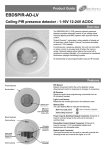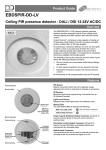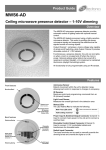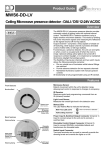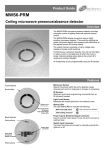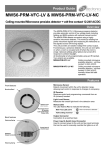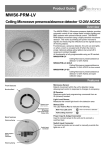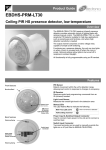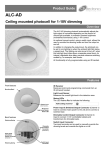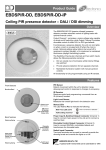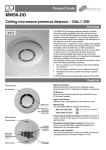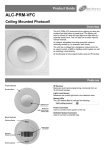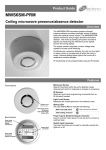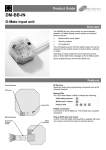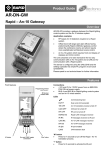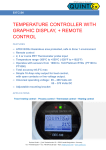Download ALC-DD - CP Electronics
Transcript
Product Guide ALC-DD Ceiling mounted photocell for DALI/DSI dimming Overview The ALC-DD dimming photocell automatically adjusts the light output of luminaires depending on the amount of natural light available, to maintain constant brightness (maintained illuminance) using either DALI or DSI digital dimming protocol. An optional manual control, using a switch input, allows the user to override the dimming levels and turn the output on and off. In addition to changing the output level, the photocell can be set to turn lighting on when the ambient light falls below a preset level. The lighting can also be set to turn off when the total light level rises above a separate preset level. An integral, adjustable time delay prevents nuisance switching caused by, for example, dark clouds. All functionality is fully programmable using an IR handset. Features Front features IR Receiver Receives control and programming commands from an IR (infrared) handset. Mounting Bezel Light Level Sensor Measures the overall light level in the detection area Status LEDs The LED flashes Red to indicate the following: Sensor Lens which covers... IR Receiver Light Level Sensor Status LED Power Input & Switched Output Connector (Channel 1) Used to connect mains power to the unit and to connect a switched load. Dimmable Control Output Connector (Channel 2) Used to connect DALI/DSI controllable ballasts and transformers for dimmable loads. Back features Retaining Spring Dimmable Control Output Connector (Channel 2) Power Input & Switched Output Connector (Channel 1) Retaining Spring Valid setting received Switch Input Connector Switch Input Connector Two input terminals can be used to manually override the dimming levels and override the lights on or off. Installation Choosing a Suitable Location The ALC-DD is designed to be ceiling mounted and must satisfy the following criteria: Avoid positioning the unit where direct sunlight may enter the sensor element. Sensor functionality Switch Level On/Off The device can be made dependant on the ambient light level using the Lux On Level and Lux Off Level parameters. Maintained Illuminance (daylight harvesting) The detector measures the overall light level in the detection area and calculates the correct output for the luminaires, to achieve a preset lux level (maintained illuminance or daylight harvesting). Burn-in Overview It is a requirement of many fluorescent lamp manufacturers to have the lamps on at maximum output for a period of time to guarantee lamp life (refer to the manufacturer’s datasheet for details) As this ALC-DD is able to dim the lamps using DALI/DSI, the product provides a facility to disable this for a given period of time. Operation By setting the “Burn in” parameter, you can select a time during which the lamps are not allowed to deviate from maximum output. The unit counts the time, and even remembers how long has elapsed in the event of a power failure. To cancel the burn in function, simply select a time of 0. Note that when the lamps are changed, the burn in time should be set again. Fault finding What if the load does not turn ON? Check that the live supply to the circuit is good. Increase the Lux on level to switch on at a higher brightness . What if the load does not turn OFF? Increase the lux off level to switch off at a lower brightness. Load cycles on and off Increase the difference between the lux on level and the lux off level. Increase the time setting. Angle the sensor away from the light that it is controlling. 2 Installation The ALC-DD is designed to be mounted using either: Flush fixing, or Surface fixing, using the optional Surface Mounting Box (part no. DBB). Both methods are illustrated below. Flush Fixing 1 Hole Ø64mm 2 3 4 2 3 4 Warning - be careful bending springs when mounting unit. Surface Fixing 1 50mm or 60mm fixing centres Pull out spring tab and rotate spring arm as shown Wire stripping details Important Ensure that the cables are formed as shown before affixing the cable clamp. The clamp MUST clamp the outer sheath(s) only. Bend cores as shown. Readback function (UNLCDHS handset only) The UNLCDHS has the ability to read back the settings stored in a device. To read back individual parameters Navigate to the parameter and press the ‘R’ (Read) button whilst pointing at the device. The handset will click when the parameter has been read back, the device will flash its LED, and the value will be shown against the parameter in the menu. To read back all of the parameters in a menu Press and hold the ‘R’ (Read) button for more than 1 second. The handset will click every time a parameter is received The device will show multiple flashes of its LED All of the values will be shown against the parameters in the menu. The individual parameters may be edited and then saved as a ‘Macro’. Notes If a parameter(s) has been missed because of a communication error, the missing value(s) is replaced by dashes. When reading back, the Channel 1 relay (where fitted) will temporarily be switched off, and will return to it’s normal state 2 seconds after the read back has been completed. 3 Wiring diagrams Standard wiring schematic also showing optional manual override switch This is a general wiring diagram. In this configuration the unit will switch the supply to a luminaire using the switched output, and dim using DALI or DSI. Manual dimming and switching can be achieved using the optional centre biased retractive switch (MK K4900 or similar). DIMMING BALLAST DIMMING LUMINAIRE (DSI or DALI) NEUTRAL LIVE CIRCUIT PROTECTION (IF REQUIRED) N L/OUT L DIMDIM+ SW1/UP SW2 DOWN CENTRE BIASED RETRACTIVE SWITCH (240V SWITCHING) (OPTIONAL) ALC-DD DIMMING OUTPUT PHOTOCELL ALC-DD being switched on by presence detector In some configurations it is useful to supply the sensor from a separate presence detector. . NEUTRAL LIVE SUPPLY CIRCUIT PROTECTION (IF REQUIRED) N L/OUT L N L/OUT L DIM+ DIM-+ SW1/UP SW2 DOWN ALC-DD DIMMING OUTPUT PHOTOCELL PRESENCE DETECTOR PLEASE NOTE! CPC's OMMITTED FOR CLARITY 4 DIMMING BALLAST NON-DIMMING LUMINAIRE(S) DIMMING LUMINAIRE(S) (DSI or DALI) Basic programming The functionality of the ALC-DD is controlled by a number of parameters which can be changed or programmed by any of the following devices: UHS5 Infrared Handset. See below for programmable functions. UNLCDHS Infrared Handset (with LCD). See user guide for full programming details. For most basic programming operations the UHS5 handset can be used and the following procedures are based on using this device. Point the handset at the Sensor and send the required programming commands to the unit as shown below. Valid commands will be indicated by a red LED flash. See page 1 for details of other LED responses. Note: other functions on the UHS5 which are not shown below are not applicable to this product. Number of Shift key presses Parameter Name Default Value 0 SHIFT 1 1 SHIFT 2 SHIFT 1 2 SHIFT 2 SHIFT 1 3 SHIFT 2 SHIFT 1 UHS5 Handset Graphics Description SHIFT 2 Button Activation On / Raise On Raise Turn lights on or to raise lights. Off / Lower Off Lower Turn lights off or to lower lights. 2, 5 & 7 4, 6 & 9 Lux level setting to prevent the luminaires being switched on if the ambient light level is sufficient (adjustable between 1 and 9). The luminaires will always be switched on at level 9. Lux on level (Switch level on) 9 Light Level 6 (600) Lux off level (Switch level off) 9 Load Type DALI 2 (200) 5 (500) 7 (700) 2, 5 & 7 4, 6 & 9 Shift 0 0 50 Sets a target light level to be maintained by the lighting system. Lux level setting to switch the luminaires off the ambient light level goes above the setting (adjustable between 1 and 9). Level 9 will always keep the lights on. This setting can be used for “window row switching”. Note: the Lux Off Level value must always be greater than the Lux On Level value. 2-DALI 7-DSI Defaults Burn-in 4 (400) 6 (600) 9 (900) 2-DALI on Sets the ballast control protocol to be used by the output channel. D Returns the unit to the default settings. 100 Determines how long the output will be at 100% so that lamps ‘burn-in’. The ’burn-in’ time is not affected by power supply interruptions. Use this button to select the settings in red and blue signified by the ‘Shift 1’ and ‘Shift 2’ LEDs 5 Advanced programming Parameter Name Default Value Range / Options Description 0 (disabled) 1-99 minutes If the detector measures the lux level and decides that the output needs switching on or off as a consequence, the lux time must elapse first. If at any time during the timed delay the lux change reverses then the process is cancelled. Lux Time enables absence detection to be implemented with a lux off level set. When the button is pressed, the lights will go on, regardless of ambient light level. However, if there is sufficient ambient light, they will turn off again after the Lux Time. Note that whenever the an external switch is pressed, whether in absence or presence mode, if the lights were out because of the lux level, they will be immediately turned on again for at least the Lux Time. Restores factory default settings UHS5 UNLCDHS Detector Parameters Lux time 0 - - Raise - - Increase light level. Lower - - Decrease light level. - Steps up between 6 pre-defined scenes. Factory default User Modes Scene up - Scene down - - Steps down between 6 pre-defined scenes. Scene # - - Select the individual scene, between 0 and 6. (1 = min. output; 2 = 10%; 3 = 25%; 4 = 50%; 5 = 75%; 6 = 100%) Override On - - If the lights are off, sending the IR command will turn them on immediately and revert to automatic operation using the manual timeout period. Override Off - - If the lights are on, sending the IR command will turn them off immediately. After the manual timeout period (described above), the sensor will revert to automatic. Cancel - - Cancels the on or off override, returning the detector to normal operation. 6 Advanced programming Parameter Name Default Value UHS5 UNLCDHS Range / Options Description 1 to 9 Sets a minimum light level below which the PIR sensor is enabled, allowing lights to be turned on by movement. Note: the Lux Level Off value must always be greater than the Lux Level On value. Sets a maximum light level above which the PIR sensor is disabled, preventing lights from being turned on by movement. Lux level setting to prevent the luminaires being switched on if the ambient light level is sufficient (adjustable between 1 and 9). The luminaires will always be switched on at level 9. Note: the Lux Level Off value must always be greater than the Lux Level On value. Lux level setting to switch the luminaires off the ambient light level goes above the setting. Channel 1 –Switching Channel Lux on level (Switch level on) 9 Lux off level (Switch level off) 9 For a higher resolution a scale of 101-199 is available 1 to 9 For a higher resolution a scale of 101-199 is available Channel 2 -Dimming Channel Lux on level (Switch level on) 9 Lux off level (Switch level off) 9 Light Level 600 1 to 998 (999 disabled) Sets a target light level to be maintained by the lighting system. DALI DSI DALI Sets the ballast control protocol to DSI. Sets the ballast control protocol to DALI. For a higher resolution a scale of 101-199 is available 1 to 9 For a higher resolution a scale of 101-199 is available (maintained illuminance) Load Type 1 to 9 DALI On Max Value 100% 0 to 100% DALI On provides a permanent voltage to DALI ballasts when DALI has not been implemented correctly in the ballast. Maximum number of ballasts is 5 unless the relay is disabled then it is 10. Maximum dimming output level. Min Value 0% 0 to 100% Minimum dimming output level. Memorise N Yes or No If this is set to Yes, the last manual lux level set will be memorised and used as the new switch on level. On value 99 0 to 99 Dimming output level when switched on (0-99). Dimming output level when switched off (0-99). If a non-zero off value is set, then the output will toggle between this value and completely off depending on the switch level on and off values. This feature is only enabled if ‘Min value’ is set to 99. Determines how long the output will be at 100% so that lamps ‘burn-in’. The ’burnin’ time is not affected by power supply interruptions. Off value 0 0 to 99 Burn-in 0 0 (disabled) or 1 to 999 hours Speed On 40 Measured in 0.1 sec intervals. Determines the dimming response speed after the setup time has finished. Speed Set 5 Measured in 0.1 sec intervals. Determines the dimming response speed during the set up time. Measured in 0.1 sec intervals. If set to 0 will disable dimming for “Set seconds” below, used if fittings are required to warm up before dimming. Set Seconds 120 1 to 999 seconds Determines how long the dimming response set-up period lasts on power-up or on setting change. This enables the desired lux level to be achieved rapidly when the lights come on, or during setup. 7 Technical data Dimensions Weight Supply Voltage Frequency Maximum Load See diagrams opposite 0.15kg 230VAC +/- 10% 50Hz Channel 1 (switching): 10A of lighting and/or ventilation ALC-DD including incandescent, fluorescent, compact fluorescent, low voltage (by switching the primary of transformer). Power consumption Dimming output Terminal Capacity Temperature Humidity Material (casing) Type IP rating Compliance Channel 2 (dimming): Maximum number of DSI or DALI ballasts is 10 unless the relay is disabled then it is 20. On 622mW, Off 792mW Basic insulation only. Although low voltage, this is not an SELV output and should be treated as if mains potential. Use mains rated wiring. 2.5mm2 -10ºC to 35ºC 5 to 95% non-condensing Flame retardant ABS and PC/ABS Class 2 IP40 DBB EMC-2004/108/EC LVD-2006/95/EC Part numbers Detector Accessories Part number ALC-DD DBB UHS5 UNLCDHS Description Ceiling mounted photocell for DALI/DSI dimming Surface mounting box Programming IR handset Universal LCD IR handset IMPORTANT NOTICE! This device should be installed by a qualified electrician in accordance with the latest edition of the IEE Wiring Regulations and any applicable Building Regulations. Due to our policy of continual product improvement CP Electronics reserves the right to alter the specification of this product without prior notice. 8 C.P. Electronics Ltd Brent Crescent London NW10 7XR United Kingdom Tel: + 44 (0) 333 900 0671 Fax: + 44 (0) 333 900 0674 www.cpelectronics.co.uk [email protected] Ref: #WD483 Issue 1








